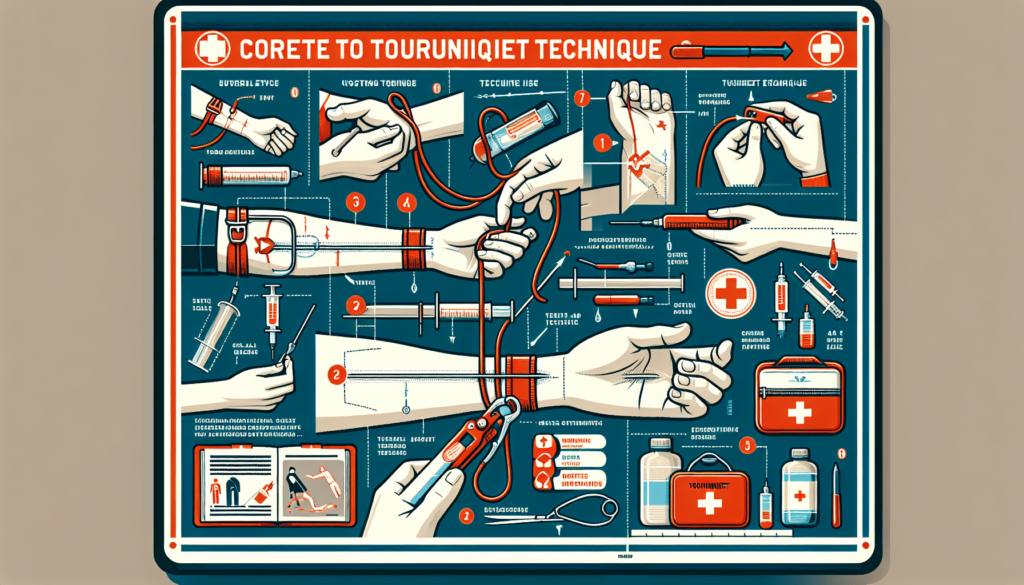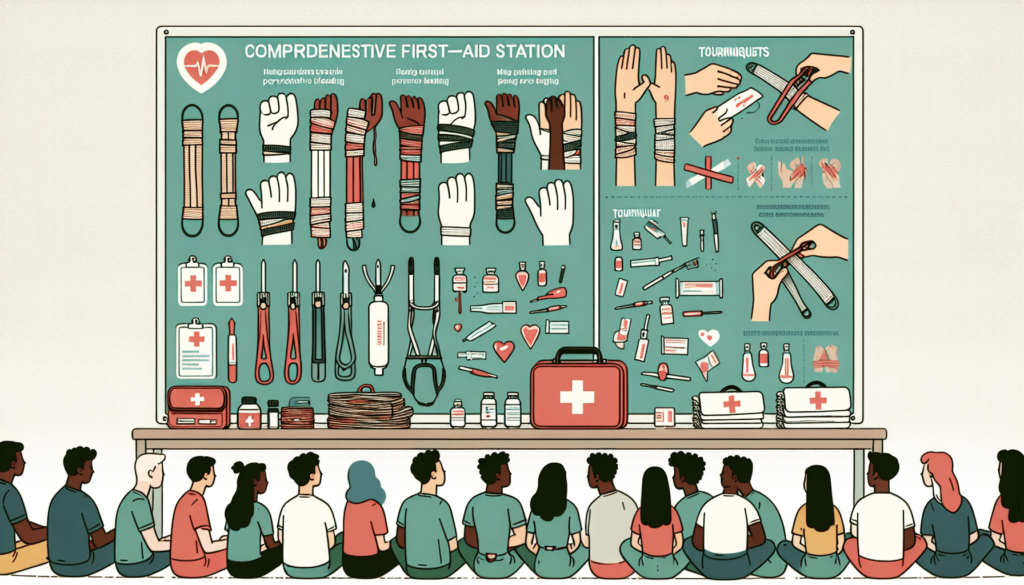Imagine embarking on a self-sufficient adventure, living off the grid with your family. Your backyard transforms into a thriving survival garden, teeming with fresh produce. You learn to identify wild plants for sustenance, while cautiously avoiding any poisonous imposters. Disaster preparedness empowers you to care for your pets during emergencies, while DIY projects like building a homemade water filter and a solar power system ensure self-reliance. Even the younger explorers get involved, mastering basic survival skills like building shelters and making fire without matches. But amidst all the excitement of this off-grid journey, it’s crucial not to overlook one vital skill: tourniquet techniques. In this article, we’ll explore why mastering this first-aid skill is essential for any self-reliant adventurer like yourself, ensuring that you’ll be prepared to handle unexpected medical emergencies in the wilderness.

Understanding Tourniquets
What is a tourniquet?
A tourniquet is a medical device used to control severe bleeding by compressing the blood vessels and stopping blood flow to a specific area of the body. It is typically a band made of a wide, strong material that can be tightened to apply pressure.
When to use a tourniquet?
Tourniquets are used in emergency situations where there is life-threatening bleeding that cannot be controlled by other means. They are typically used when direct pressure, elevation, and the use of dressings or bandages fail to stop the bleeding.
Types of tourniquets
There are various types of tourniquets available, including improvised tourniquets, commercial tourniquets, and pneumatic tourniquets. Improvised tourniquets are made using everyday items, while commercial tourniquets are specifically designed for medical use. Pneumatic tourniquets use air pressure to compress blood vessels and are commonly used during surgical procedures.
Tourniquet Application
Proper placement of a tourniquet
When applying a tourniquet, it is important to place it at least two to three inches above the bleeding site, closer to the heart. The tourniquet should be positioned on bare skin, if possible, and above any joints. It is essential to avoid placing the tourniquet directly over a bone or wound.
Determining the tightness
The tightness of a tourniquet is crucial for its effectiveness. It should be tight enough to stop arterial bleeding but not so tight as to damage nerves or other tissues. A properly applied tourniquet should completely stop the flow of blood distal to the tourniquet.
Securing the tourniquet
Once the tourniquet is applied and tightened, it should be securely fastened to maintain its position and prevent it from becoming loose or slipping. This can be done by using a self-adhesive strap or by tucking the end of the tourniquet under itself.
Tourniquet Safety Precautions
Potential risks and complications
While tourniquets can be lifesaving, they also come with potential risks and complications. Prolonged use of a tourniquet can cause tissue damage, nerve injury, and even limb loss in extreme cases. It is important to monitor the patient closely and seek medical attention as soon as possible.
Time limits for tourniquet application
Tourniquets should only be used as a temporary measure to control severe bleeding. Prolonged tourniquet application can lead to tissue ischemia and other complications. It is generally recommended to release the tourniquet every two hours for a few minutes to allow blood flow to the affected area.
Monitoring the patient
While a tourniquet is in place, it is crucial to continuously monitor the patient’s vital signs and assess the condition of the limb distal to the tourniquet. Any changes in the patient’s condition should be promptly reported to medical professionals.
Recognizing Life-Threatening Bleeding
Signs and symptoms of severe bleeding
Severe bleeding can be characterized by the presence of bright red blood, blood pooling or squirting, and a rapid loss of blood volume. Other signs may include weakness, dizziness, paleness, and altered mental status.
Assessing the severity of bleeding
Assessing the severity of bleeding is essential to determine the need for a tourniquet. If direct pressure and dressings fail to control the bleeding, and the patient’s life is at immediate risk, a tourniquet should be considered.
Indications for tourniquet use
Tourniquets are indicated for life-threatening bleeding that cannot be controlled by other methods. This includes arterial bleeding, bleeding from amputations, or severe injuries where immediate control of bleeding is necessary.

Step-by-Step Tourniquet Application
Assessing the situation
Before applying a tourniquet, it is important to assess the situation and ensure your own safety. Evaluate the severity of the bleeding, the availability of proper medical assistance, and the need for immediate action.
Preparing the tourniquet
If using a commercial tourniquet, familiarize yourself with its instructions for use. Ensure the tourniquet is functional and easily accessible. If using an improvised tourniquet, gather the necessary materials and prepare them for quick application.
Applying the tourniquet
Position the tourniquet correctly above the bleeding site. Tighten the tourniquet until the bleeding stops, using a twisting or turning motion if applicable. Secure the tourniquet in place and make a note of the time of application.
Tourniquet Removal and Follow-up Care
When to remove a tourniquet
A tourniquet should be removed as soon as medical assistance is available or when the bleeding is controlled by other means. Avoid removing the tourniquet yourself unless you have received specific training and guidance.
How to remove a tourniquet safely
To remove a tourniquet safely, slowly release the pressure by loosening or unwinding it. Monitor the patient closely for any signs of re-bleeding and seek medical attention immediately.
Post-tourniquet care for the patient
After tourniquet removal, it is essential to provide appropriate wound care and monitor the patient for any complications, such as infection or swelling. Follow up with medical professionals to ensure proper healing and recovery.
Special Considerations
Tourniquets for different age groups
The use of tourniquets may vary depending on the age and size of the patient. Special considerations must be made for pediatric patients, as their anatomy and needs differ from adults. It is crucial to receive specific training on pediatric tourniquet application.
Tourniquets in specific situations
Mass casualty incidents and other emergency situations may require the use of tourniquets on multiple patients simultaneously. It is important to follow established protocols and guidelines in these situations to ensure efficient and effective use of tourniquets.
Alternate techniques for controlling bleeding
While tourniquets are effective in controlling severe bleeding, other techniques such as direct pressure, wound packing, and the use of hemostatic agents can also be used. It is essential to assess the situation and choose the most appropriate method based on the severity and location of the bleeding.
Training and Certification
Importance of proper training
Proper training in tourniquet application and first aid techniques is vital to ensure effective and safe use. Without proper training, there is a risk of inadequate application, ineffective bleeding control, and unnecessary complications. Seek certified training programs to gain the necessary skills and knowledge.
Certification programs for tourniquet use
Certification programs for tourniquet use are available for healthcare professionals and individuals who may need to administer first aid in emergency situations. These programs provide comprehensive training on tourniquet application, safety precautions, and follow-up care.
Continuing education on tourniquet techniques
As tourniquet technology and techniques continue to evolve, it is important to stay updated with the latest advancements and recommendations. Engage in continuing education opportunities, attend workshops, and participate in simulations to enhance your skills and knowledge.
Common Myths and Misconceptions
Myth: Tourniquets always lead to amputation
Contrary to popular belief, tourniquets do not always lead to amputation. When properly applied and used for a limited duration, tourniquets can be a life-saving tool without resulting in permanent damage or limb loss.
Misconception: Tourniquets should only be used as a last resort
While tourniquets are often considered a last resort in bleeding control, they can be used earlier in the management of life-threatening bleeding. Tourniquets should be applied when direct pressure and other methods fail to control bleeding, or when immediate action is necessary to save a life.
Debunking other misconceptions surrounding tourniquets
There are various misconceptions surrounding tourniquets, such as the belief that they are painful or ineffective. These misconceptions stem from outdated practices and lack of knowledge. Modern tourniquets are designed to be effective, safe, and easy to use, minimizing discomfort for the patient.
Future of Tourniquet Technology
Advancements in tourniquet design
Tourniquet technology is constantly evolving to improve performance and patient outcomes. Advancements include the development of tourniquets with automatic pressure regulation, integrated monitoring systems, and improved materials for increased comfort and durability.
Smart tourniquets and remote monitoring
Smart tourniquets equipped with sensors and connectivity capabilities are being developed to enable remote monitoring of a patient’s condition and tourniquet status. These technologies can provide real-time data and improve the effectiveness of tourniquet application and safety.
Potential impact on first aid and emergency response
The future of tourniquet technology has the potential to revolutionize first aid and emergency response. Enhanced tourniquet designs can simplify application, improve bleeding control, and provide valuable data for medical professionals. This advancement can significantly improve patient outcomes in critical situations.
In conclusion, understanding tourniquets is crucial for anyone involved in emergency situations where severe bleeding occurs. Knowing when and how to properly apply a tourniquet can save lives and prevent further complications. By debunking myths, staying updated on advancements, and seeking proper training and certification, individuals can enhance their first aid skills and contribute to better patient outcomes. The future of tourniquet technology holds promising possibilities, paving the way for improved bleeding control and emergency response.

